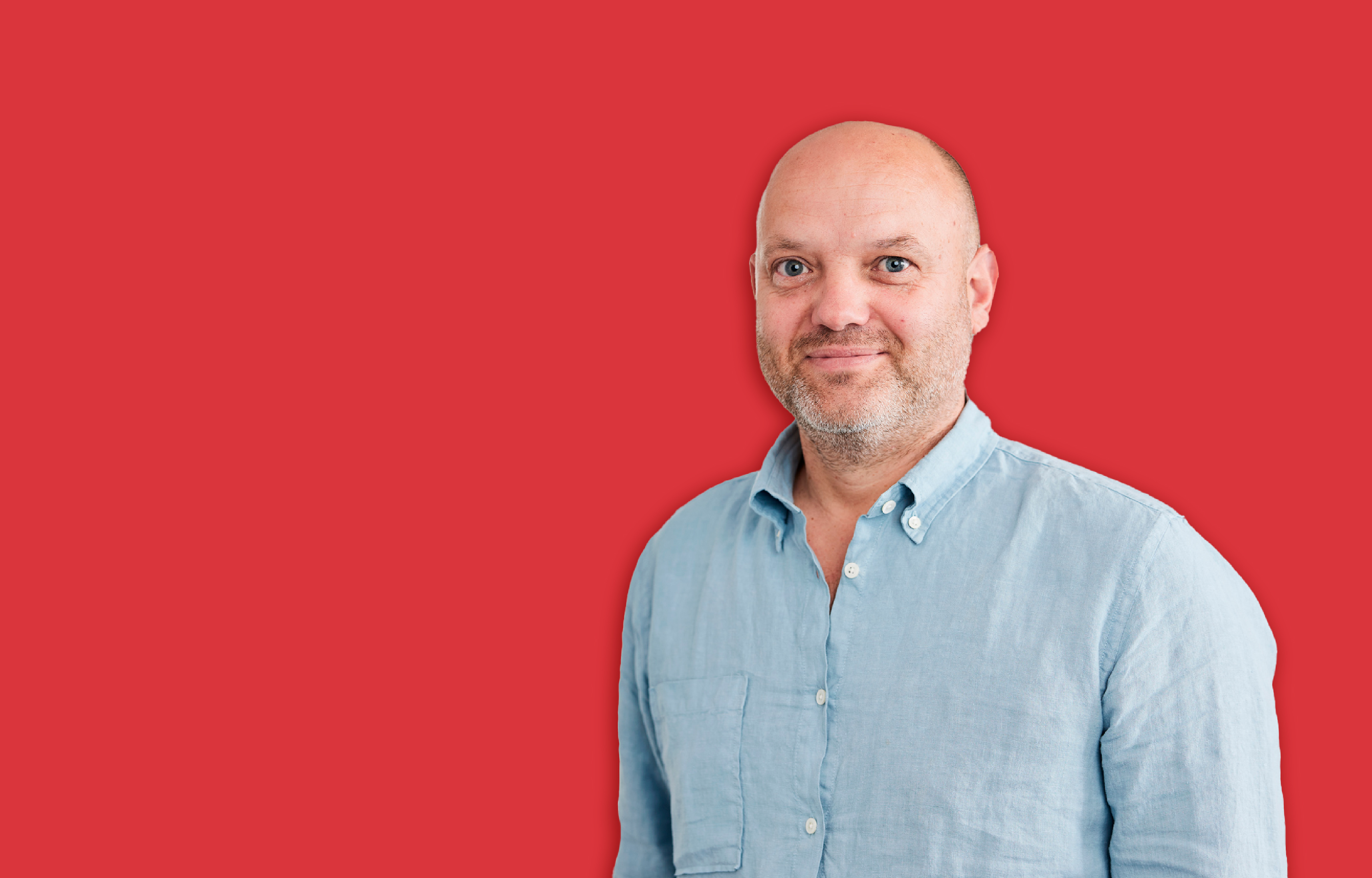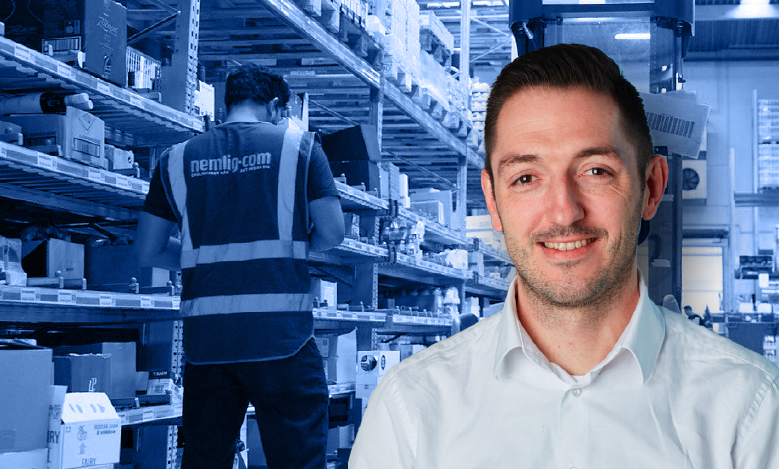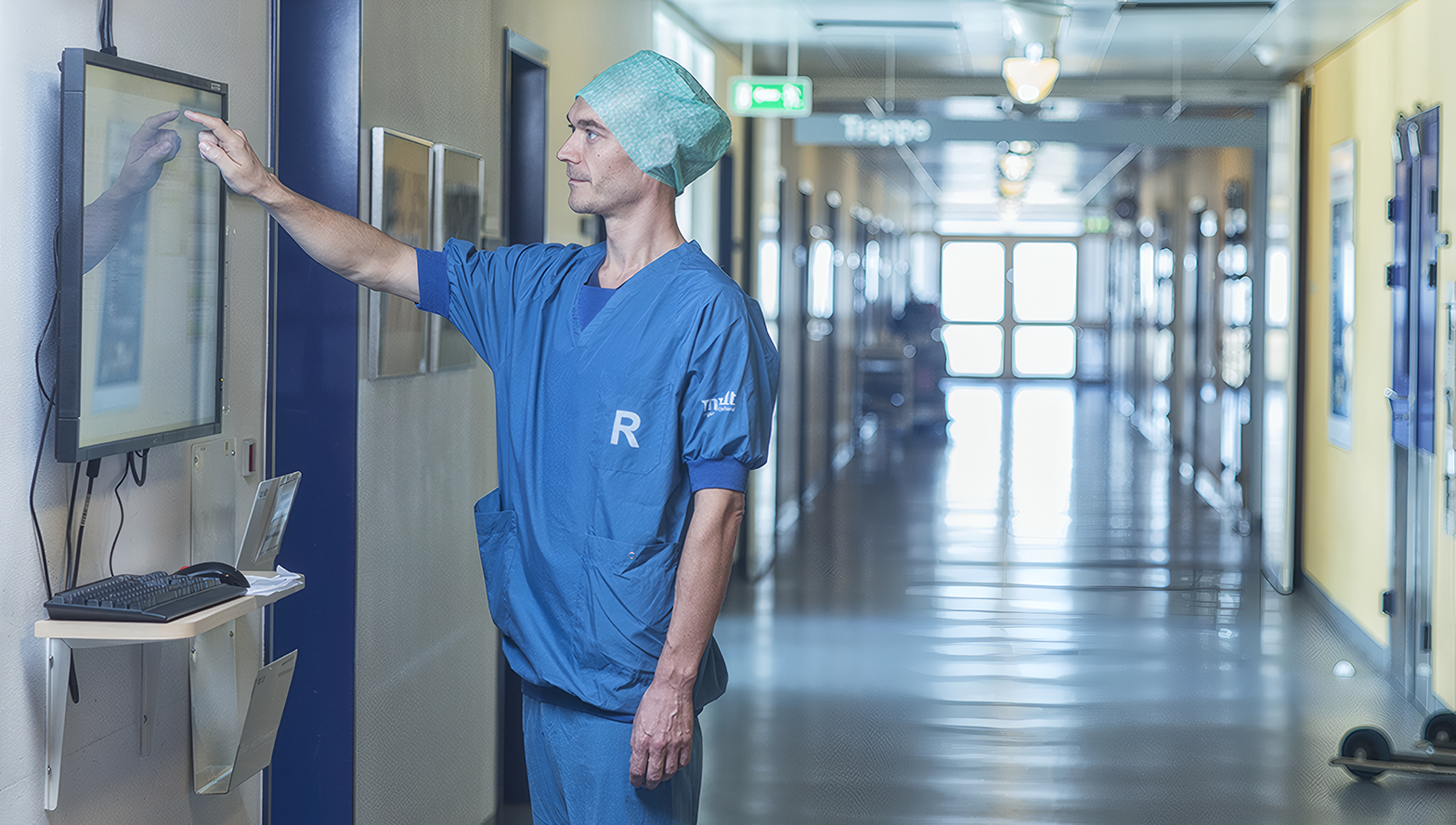

8 min.
October 2, 2025
GS1 standards help locate staff and create peace of mind
Text:
Karen Gahrn
Photo:
Central Jutland Region
Being able to see if an employee is busy treating a patient, for example, has created greater peace of mind. The system, which uses GS1 standards, is now a fully integrated part of everyday life in the department.
Aarhus University Hospital in Skejby is equipped with almost 7,500 antennas and around 25,000 RFID tags are placed on a wide range of hospital objects such as beds and medical equipment. This makes it possible to know where things are at any given time.
The Department of Elderly Diseases has gone one step further when it comes to localization. They are the only hospital department in Denmark to have equipped all employees with a staff card with a chip, which also makes it possible to see where they are at any given time. The common 'language' that makes it possible to share and use this information is GS1 standards, which play a key role in ensuring better processes for staff in the department.
Nurse Marie Nielsen has been involved from the start when the department began working with staff localization:
- In the beginning, there was talk about surveillance, including something like: 'Can you see when I'm on the toilet? But you can't. So it passed quickly, because that's not how we use the system. We use it to strengthen collaboration and patient safety. And we have experienced that localization results in less disruption and less anxiety," she says.
- If I need a colleague, but I can see that she's in a room with a patient, I'll wait until she's out.
Peter Krogh Brynningsen is chief physician at the department:
- I can easily be called many times in a day. And we work a lot in the department to eliminate inappropriate contacts, which is where the localization system helps. For example, we have patient interviews where we have gathered patients and relatives and the interdisciplinary team. It's important for us, but also for the patients, to reduce inappropriate contacts. Now the other staff can see that I'm in a conversation room," he says.
- I may also need to have a conversation with a nurse before a patient is discharged, and before I send out a message, I'll check. In other words, it goes both ways, it's also a question of not disturbing the nurses in their work.
Pia Serwin is a medical secretary at the Department of Elderly Diseases:
- I quickly realized that it's a really good system. I sit with the coordinator, so I use the system on the computer and can quickly check where a person is instead of calling or maybe having to go out and look for them. So it saves time in everyday life.
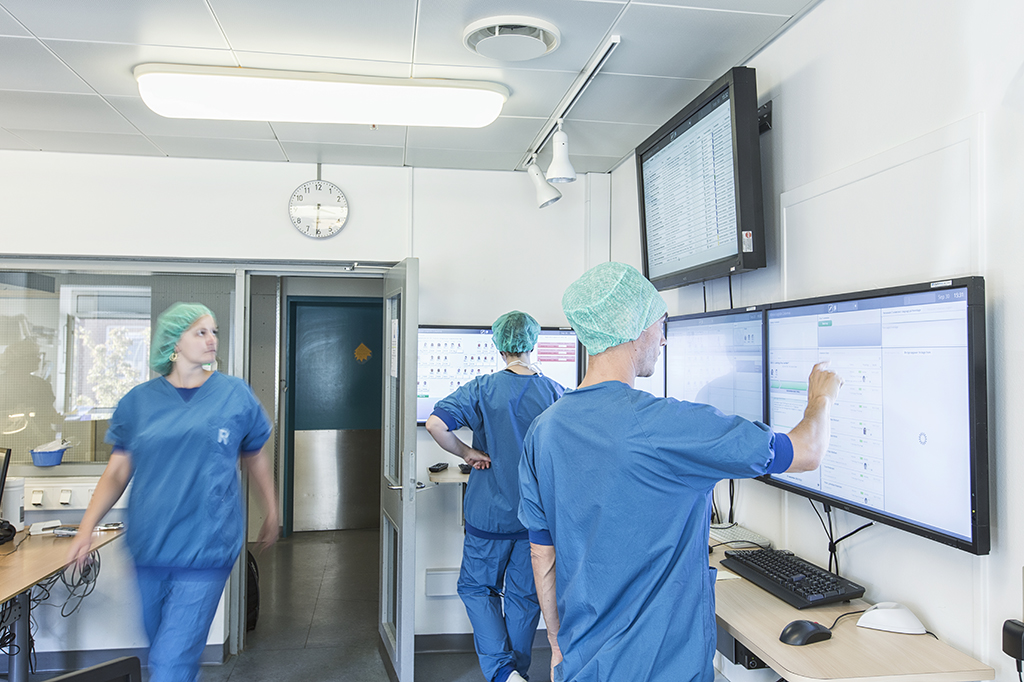



In the beginning, there was talk about surveillance, including something like: 'Can you see when I'm on the toilet? But you can't. So it passed quickly, because that's not how we use the system. We use it to strengthen collaboration and patient safety. And we've found that localization results in less disruption and less anxiety
GS1 has given us a common language
Claus Bugge is product manager and project manager in Central Denmark Region's central IT organization and is responsible for the localization systems.
- After all, staff is a resource that is only available to a limited extent. It's no secret that both doctors and nurses are busy. So, having invested in all these antennas, we've looked at how we can create value by not only localizing things, but also localizing people. It's about creating better collaboration, better communication, better capacity management and an opportunity for different professional groups to see where their colleagues are," says Claus Bugge.
- From the start, we were tasked with looking at how to use a technology that is already widely used in, for example, retail, which has a great need to keep track of where goods are. How could hospitals benefit from this technology? "We had the hardware technology, we had software systems developed by suppliers, and we worked closely with GS1 on standards along the way," he explains.
For Claus Bugge, GS1 has been a new business partner.
- I've been surprised by how engaged GS1 has been in how their standards create value in the healthcare sector. They are not driven by selling IT systems to hospitals, but I have experienced that they have a great interest in how their standards are used. We've had a really good collaboration, and I've been to Copenhagen and visited GS1 several times.
Claus Bugge has found GS1's standards to be a good foundation for the entire localization system.
- We have been able to say to our software suppliers: 'You must comply with these standards'. If we didn't have the standards, there would have been more anarchy and it would have been our software suppliers who would have set the agenda. Now we lean on a common language that GS1 has given us.
Claus Bugge is product manager and project manager in Central Denmark Region's central IT organization and is responsible for the localization systems.
- After all, staff is a resource that is only available to a limited extent. It's no secret that both doctors and nurses are busy. So, having invested in all these antennas, we've looked at how we can create value by not only localizing things, but also localizing people. It's about creating better collaboration, better communication, better capacity management and an opportunity for different professional groups to see where their colleagues are," says Claus Bugge.
- From the start, we were tasked with looking at how to use a technology that is already widely used in, for example, retail, which has a great need to keep track of where goods are. How could hospitals benefit from this technology? "We had the hardware technology, we had software systems developed by suppliers, and we worked closely with GS1 on standards along the way," he explains.
For Claus Bugge, GS1 has been a new business partner.
- I've been surprised by how engaged GS1 has been in how their standards create value in the healthcare sector. They are not driven by selling IT systems to hospitals, but I have experienced that they have a great interest in how their standards are used. We've had a really good collaboration, and I've been to Copenhagen and visited GS1 several times.
Claus Bugge has found GS1's standards to be a good foundation for the entire localization system.
- We have been able to say to our software suppliers: 'You must comply with these standards'. If we didn't have the standards, there would have been more anarchy and it would have been our software suppliers who would have set the agenda. Now we lean on a common language that GS1 has given us.
Time savings, peace of mind and patient safety
Since moving into the new hospital in the spring of 2017, the Department of Elderly Diseases has decided to embrace the future and use the new technology to also locate employees.
- Now we are systematically investigating what value the system has created in the department. We can only improve the system in collaboration with the users, which is why their feedback is indispensable," says Claus Bugge.
For medical secretary Pia Serwin, saving time is the biggest benefit:
- I can see that Peter is right there and quickly decide whether I can call him or wait," she says.
Consultant Peter Krogh Brynningsen has no doubt about the benefits for everyone in the department:
- It makes for a better working environment and better quality when we can reduce inappropriate contacts. When I get a call from our coordinator or a secretary when I'm out of the room instead of during a conversation, I think: '1000 thanks for that'. It's important for both me and the patient," he says.
Nurse Marie Nielsen agrees:
- We have a patient group that is easily disturbed by a phone call, for example. Hospitalization can be confusing enough already, so providing as much calm as possible is important especially for older patients.
- We clearly work most efficiently if we have the opportunity to finish the task we are working on before moving on to something else. Reducing interruptions means a lot for my work environment, but it also means something for patient safety," says the consultant.
- During the corona pandemic, we had many isolation rooms, which made it even more important that we didn't have to open a lot of doors to look for a person. That's where localization meant a lot, it provided much better security. And we still have isolation rooms for corona or flu patients.




Staff localization built on GS1 standards
Electronic Product Code Information Services (EPCIS) is the GS1 standard used to capture and share incident data across systems. The standard creates transparency and makes it possible to answer the questions: what, when, where, why and how.
For the system to work, all devices must be identified with GS1 numbers - for example GTIN for equipment and GLN for locations. RFID/EPC tags act as physical information carriers that can be read and contain the GS1 numbers that identify objects or people.
When it comes to personnel localization, each employee chip has a unique code (EPC or tag ID). This code is linked in the region's systems to a person identifier (GSRN), which is the GS1 standard for identifying service relationships.
This makes it possible to show that nurse NN is located in room X, where the location is based on GS1's GLN.
Staff information is not stored
Employees in the Department of Elderly Care have a chip with their staff card, which they all use to open doors, for example. Each chip has a unique ID and every time the employee enters a new room, the antenna in the room detects that they are now here.
The information can be viewed on the department's logistics boards, which contain the entire department's capacity management: who is at work, where are the patients, which ward doctors are available, which nurses and secretaries are on duty. On the board is a picture of each employee with various information - so now you can also see where they are.
On the large 65-inch touchscreen you can also type: 'Where is Pia? If the screen does not immediately provide the answer. The information can also be accessed via a computer and staff smartphone as needed.
In everyday life, doctors and nurses often use the logistics screens, while coordinators and secretaries work at a computer and find information here.
- It is an important task for us to get the localization messages onto the platforms that the clinics are already on. The information must be easily accessible, intuitive and be found where the employees are," says Claus Bugge.
It is important for Claus Bugge to emphasize that the information about where employees are staying is not stored.
- Technology allows for better support for staff, not monitoring them. Employee location data is only a live view in the here and now. When we put RFID tags on a ventilator or a trolley, we store the information so we can track if and where the equipment has been used. When it comes to staff, we can only show where that resource is right now. We are not allowed to store this information. This is how the system is designed. It distinguishes between technical equipment and people.
The future of workforce localization
The development of new localization technology continues, which means that in the future, staff could potentially have access to too much information. And here you can use the knowledge of where the person is to ensure that information goes to the right person at the right time, so that not all nurses are disturbed if, for example, a patient has fallen out of bed.
- We are working to make the information more accessible and easier to use. For example, not everyone may know where room J 214 is, so you will also be able to see it on a map," says Claus Bugge.
The goal is to introduce the technology to other departments at Aarhus University Hospital and Regional Hospital Gødstrup near Herning, which already has the infrastructure but is not as far along with widespread localization in the clinic. Claus Bugge and his colleagues also communicate closely with hospitals on Zealand and the new hospitals in Odense and Aalborg.
- We have agreed to use GS1 standards. And because we use the open standards from GS1 and have open interfaces, all we have to say to suppliers and innovation initiatives is: "Dig into this information and use it to create value," says Claus Bugge.
- Overall, the goal is to create value, not control. When we look broadly at localization technology, it should improve efficiency, support sustainability and contribute to data-driven decision support. It should lead to better patient care, resource management and process automation. And it's the last two in particular that we can strengthen when we know where the staff are.
The head doctor has the last word:
- The localization system means something to me, it means something to the people I work with - and it means something to the most important people, namely patients and relatives. And it's a bit thought-provoking that when the system was down at one point, everyone complained that they were missing it. And that's probably because it's a good thing to have," says Peter Krogh Brynningsen.
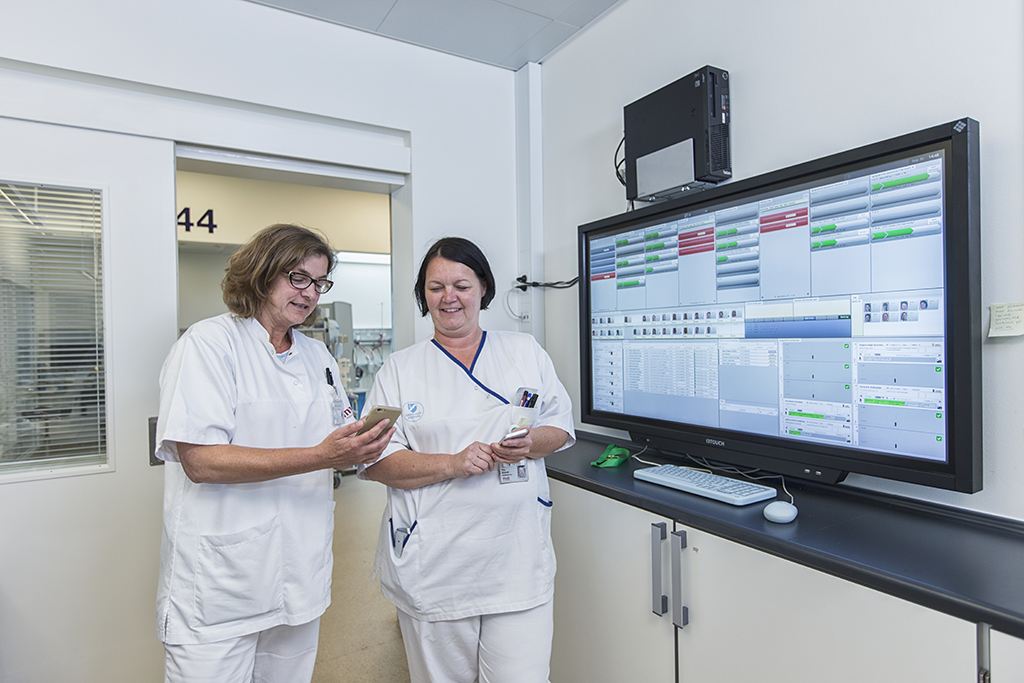



- We have been able to say to our software suppliers: 'You must comply with these standards'. If we didn't have the standards, there would have been more anarchy and it would have been our software suppliers who would have set the agenda. Now we lean on a common language that GS1 has given us.





